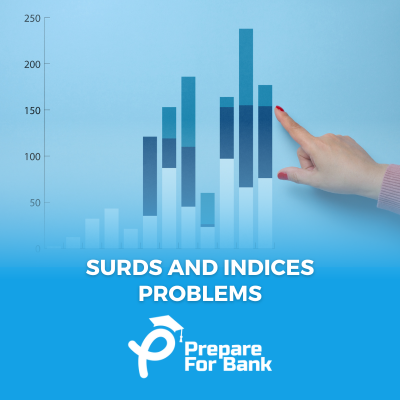Surds and Indices Problems: Learn the important concepts, formulae, and tricks to solve questions based on surds and indices. This topic is important for basic building blocs of Quantitative aptitude for bank exam preparation.
Before learning to solve Surds and Indices Problems, knowledge of the below topics are essential for clear understanding:
Indices
An index (plural: Indices) is a number that is raised to a power of any given number. The base number ‘a’ raised to the power of ‘m’ which is equal to the product of number ‘a’ for ‘m’ number of times. The base number is ‘a’ and Indices is ‘m’. For example: am
Understanding Surds and Indices concept is very useful in many other mathematical problems, such as finding area/volumes or in arithmetic and geometric series progression.
Laws of Indices
Multiplication
Multiplication of ‘a’ base number with power of ‘m’ and ‘a’ base number with power of ‘n’, result will be base number power to ‘m+n’. Example: am x an = am+n
Numeric Example: 22 X 23 = 2(2+3) = 25 = 2 x 2 x 2 x 2 x 2 = 32
Division
Division of ‘a’ base number with a power of ‘m’ by ‘a’ base number with a power of ‘n’, the result will be base number power to ‘m-n’. Example: am / an = am-n
Numeric Example: 23 / 22 = 2(3-2) = 21 = 2 = 2
Bracket
Power of ‘a’ base number with a power of ‘m’ and itself power of ‘n’, the result will be base number power to ‘m x n’. Example: (am)n = am x n
Numeric Example: (22)3 = 22 x 3 = 26 = 64
Negative Power
If a base number ‘a’ having negative power such as ‘-m’ then that number can be denominated as 1/am. For Example: a-m = 1/am
Power of Zero
Any base number to the power of zero is one. For Example: a0 = 1
Fractional Power
Both the numerator and denominator of a fractional power have meaning. The bottom of the fraction stands for the type of root; for example, a1/n denotes a n root n√a. The top line of the fractional power gives the usual power of the whole term. For Example: am/n = (n√a)m
Surds
Surds are irrational numbers that cannot be simplified further to remove ‘n’ root. When we try to remove the root of any number and it keeps on repeating number and the value goes on and on, these numbers are called Surds.
Examples of Surds
| Number | Simplified | Decimal | Is Surds? |
| √2 | √2 | 1.4142.. | Yes, It’s Surds |
| √3 | √3 | 1.7320… | Yes, It’s Surds |
| √4 | 2 | 2 | No, It’s not a Surds |
| √1/16 | 1/4 | 0.25 | No, It’s not a Surds |
| 5√3 | 5√3 | 1.2457 | Yes, It’s Surds |
Six Rules of Surds
Rule 1
n√a = a1/n
Example: 5√32 = (32)1/5 = (25)1/5 = 2.
Rule 2
n√(ab) = n√a x n√b
Example: 3√(8 x 27) = 3√8 x 3√27 = 3√(23) x 3√(33) = 2 x 3 = 6.
Rule 3
n√(a/b) = n√(a) / n√(b)
Example: 2√(16/4) = 2√16 / 2√4 = 2√(42) / 2√(22) = 4 / 2 = 2.
Rule 4
n√(an) = [(a)1/n]n = a
Example: 3√(273) = [(27)1/3]3 = 27.
Rule 5
m√n√a = mn√a
Example: 2√3√64 = 2 X 3√64 = 6√64 = 6√(26) = 2.
Rule 6
[n√a]m = n√(am)Example: [4√4]2 = 4√(42) = 4√16 = 4√(24) = 2.
Conjugate of Surds
To conjugate any given Surds, we have to create an equally opposite equation. This is done by changing the addition operation to subtraction and vice-versa.
Example: 3√6 + √3. Conjugate is: 3√6 – √3
How to Solve Surds?
You need to find some rules to solve Surds, also there’s a method to rationalize the denominator. This is done by multiplying the Surds as shown in the example below:

Application of Surds and Indices Problems
Surds and Indices problems provide ways to identify mathematical equations and to analyze correct rules that can be applied to get a solution. However, these are the basic building blocks of Mathematics and it finds their application in solving the below types of questions:
- Quadratic equations
- Mensuration
- Scientific Notation of Speed and Distance
FAQs
What is Surds?
Surds are irrational numbers that cannot be simplified further to remove ‘n’ root.
What is Indices?
An index (plural: Indices) is a number that is raised to the power of any given number. Example: 23, 3 is Indices.
How to solve Surds and Indices Problems?
To solve Surds and Indices we have six rules, applying which we can solve the given problems on Surds and Indices.
All roots are Surds?
No, all roots are not Surds. For example: √4 is not a Surds, but √2 is Surds.
All irrational numbers are Surds?
No, all irrational numbers are not Surds. When any number is a root and irrational, it is a Surds.
Practise Surds and Indices Problems
Courses you might be interested in
-
0 Lessons







